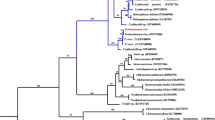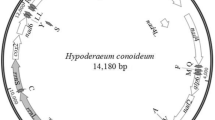Abstract
Opisthorchis viverrini and Clonorchis sinensis are important trematodes infecting humans and animals, belonging to the family Opisthorchiidae. In the present study, we sequenced the nearly complete mitochondrial (mt) DNA (mtDNA) sequences of O. viverrini from Laos, obtained the complete mtDNA sequences of C. sinensis from China and Korea, and revealed their gene annotations and genome organizations. The mtDNA sequences of O. viverrini, C. sinensis (China isolate), C. sinensis (Korea isolate) were 13,510, 13,879, and 13,877 bp in size, respectively. Each of the three mt genomes comprises 36 genes, consisting of 12 genes coding for proteins, two genes for rRNA, and 20 genes (O. viverrini) or 22 genes (C. sinensis) for tRNA. The gene content and arrangement are identical to that of Fasciola hepatica, and Paragonimus westermani, but distinct from Schistosoma spp. All genes are transcribed in the same direction and have a nucleotide composition high in T. The contents of A + T of the mt genomes were 59.39% for O. viverrini, 60.03% for C. sinensis (China isolate), and 59.99% for C. sinensis (Korea isolate). Phylogenetic analyses using concatenated amino acid sequences of the 12 protein-coding genes, with three different computational algorithms [maximum parsimony, maximum likelihood, and Bayesian analysis], all revealed distinct groups with high statistical support, indicating that O. viverrini and C. sinensis represent sister taxa. These data provide additional novel mtDNA markers for studying the molecular epidemiology and population genetics of the two liver flukes and should have implications for the molecular diagnosis, prevention, and control of opisthorchiasis and clonorchiasis in humans and animals.


Similar content being viewed by others
References
Blair D, Le TH, Després L, McManus DP (1999) Mitochondrial genes of Schistosoma mansoni. Parasitology 119:303–313
Boonjaraspinyo S, Boonmars T, Aromdee C, Kaewsamut B (2010) Effect of fingerroot on reducing inflammatory cells in hamster infected with Opisthorchis viverrini and N-nitrosodimethylamine administration. Parasitol Res 106:1485–1489
Cai XQ, Xu MJ, Wang YH, Qiu DY, Liu GX, Lin A, Tang JD, Zhang RL, Zhu XQ (2010) Sensitive and rapid detection of Clonorchis sinensis infection in fish by loop-mediated isothermal amplification (LAMP). Parasitol Res 106:1379–1383
Catanese G, Manchado M, Infante C (2010) Evolutionary relatedness of mackerels of the Catanese genus Scomber based on complete mitochondrial genomes: strong support to the recognition of Atlantic Scomber colias and Pacific Scomber japonicus as distinct species. Gene 452:35–43
Chen HX, Sundberg P, Norenburg JL, Sun SC (2009) The complete mitochondrial genome of Cephalothrix simula (Iwata) (Nemertea: Palaeonemertea). Gene 442:8–17
Chen J, Xu H, Zhang Z, Zeng S, Gan W, Yu X, Hu X (2011) Cloning and expression of 21.1-kDa tegumental protein of Clonorchis sinensis and human antibody response to it as a trematode-nematode pan-specific serodiagnosis antigen. Parasitol Res 108:161–168
Elise MK, Tarig H, Thomas R (1998) The mitochondrial genome of Onchocerca volvulus: sequence, structure and phylogenetic analysis. Mol Biochem Parasitol 95:111–127
Guindon S, Gascuel O (2003) A simple, fast, and accurate algorithm to estimate large phylogenies by maximum likelihood. Syst Biol 52:696–704
Hu M, Chilton NB, Gasser RB (2002) The mitochondrial genomes of the human hookworms, Ancylostoma duodenale and Necator americanus (Nematoda: Secernentea). Int J Parasitol 32:145–158
Hu M, Chilton NB, Gasser RB (2003) The mitochondrial genome of Strongyloides stercoralis (Nematoda) idiosyncratic gene order and evolutionary implications. Int J Parasitol 33:1393–1408
Kaewkes S (2003) Taxonomy and biology of liver flukes. Acta Trop 88:177–186
Kang S, Sultana T, Loktev VB, Wongratanacheewin S, Sohn WM, Eom KS, Park JK (2008) Molecular identification and phylogenetic analysis of nuclear rDNA sequences among three opisthorchid liver fluke species (Opisthorchiidae: Trematoda). Parasitol Int 57:191–197
Keddie EM, Higazi T, Unnasch TR (1998) The mitochondrial genome of Onchocerca volvulus: sequence, structure and phylogenetic analysis. Mol Biochem Parasitol 95:111–127
Kiatsopit N, Sithithaworn P, Sithithaworn J, Boonmars T, Tesana S, Pitaksakulrat O, Saijuntha W, Petney TN, Andrews RH (2011) Genetic relationships within the Opisthorchis viverrini species complex with specific analysis of O. viverrini from Savannakhet, Lao PDR by multilocus enzyme electrophoresis. Parasitol Res 108:211–217
Kim KH, Eoma KS, Park JK (2006) The complete mitochondrial genome of Anisakis simplex (Ascaridida: Nematoda) and phylogenetic implications. Int J Parasitol 36:319–328
Le TH, Blair D, McManus DP (2000) Mitochondrial DNA sequences of human schistosomes: the current status. Int J Parasitol 30:283–290
Le TH, Humair PF, Blair D, Agatsuma T, Littlewood DT, McManus DP (2001a) Mitochondrial gene content, arrangement and composition compared in African and Asian schistosomes. Mol Biochem Parasitol 117:61–71
Le TH, Blair D, McManus DP (2001b) Complete DNA sequence and gene organization of the mitochondrial genome of the liver fluke, Fasciola hepatica L. (Platyhelminthes; Trematoda). Parasitology 123:609–621
Li MW, Lin RQ, Song HQ, Wu XY, Zhu XQ (2008) The complete mitochondrial genomes for three Toxocara species of human and animal health significance. BMC Genomics 9:224
Littlewood DT, Lockyer AE, Webster BL, Johnston DA, Le TH (2006) The complete mitochondrial genomes of Schistosoma haematobium and Schistosoma spindale and the evolutionary history of mitochondrial genome changes among parasitic flatworms. Mol Phylogenet Evol 39:452–467
Liu GH, Lin RQ, Li MW, Liu W, Liu Y, Yuan ZG, Song HQ, Zhao GH, Zhang KX, Zhu XQ (2011) The complete mitochondrial genomes of three cestode species of Taenia infecting animals and humans. Mol Biol Rep 38:2249–2256
Lowe TM, Eddy SR (1997) tRNAscan-SE: A program for improved detection of transfer RNA genes in genomic sequence. Nucleic Acids Res 25:955–964
Lun ZR, Gasser RB, Lai DH, Li AX, Zhu XQ, Yu XB, Fang YY (2005) Clonorchiasis: a key foodborne zoonosis in China. Lancet Infect Dis 5:31–41
Marcos LA, Terashima A, Gotuzzo E (2008) Update on hepatobiliary flukes: fascioliasis, opisthorchiasis and clonorchiasis. Curr Opin Infect Dis 21:523–530
Nakao M, Abmed D, Yamasaki H, Ito A (2007) Mitochondrial genomes of the human broad tapeworms Diphyllobothrium latum and Diphyllobothrium nihonkaiense (Cestoda: Diphyllobothriidae). Parasitol Res 101:233–236
Olson PD, Cribb TH, Tkach VV, Bray RA, Littlewood DT (2003) Phylogeny and classification of the Digenea (Platyhelminthes: Trematoda). Int J Parasitol 33:733–755
Pak JH, Moon JH, Hwang SJ, Cho SH, Seo SB, Kim TS (2009) Proteomic analysis of differentially expressed proteins in human cholangiocarcinoma cells treated with Clonorchis sinensis excretory-secretory products. J Cell Biochem 108:1376–1388
Park GM (2007) Genetic comparison of liver flukes, Clonorchis sinensis and Opisthorchis viverrini, based on rDNA and mtDNA gene sequences. Parasitol Res 100:351–357
Posada D, Crandall KA (1998) Modeltest: testing the model of DNA substitution. Bioinformatics 14:817–818
Ronquist F, Huelsenbeck JP (2003) MrBayes 3: Bayesian phylogenetic inference under mixed models. Bioinformatics 19:1572–1574
Shekhovtsov SV, Katokhin AV, Romanov KV, Besprozvannykh VV, Fedorov KP, Yurlova NI, Serbina EA, Sithithaworn P, Kolchanov NA, Mordvinov VA (2009) A novel nuclear marker, Pm-int9, for phylogenetic studies of Opisthorchis felineus, Opisthorchis viverrini, and Clonorchis sinensis (Opisthorchiidae, Trematoda). Parasitol Res 106:293–297
Shekhovtsov SV, Katokhin AV, Kolchanov NA, Mordvinov VA (2010) The complete mitochondrial genomes of the liver flukes Opisthorchis felineus and Clonorchis sinensis (Trematoda). Parasitol Int 59:100–103
Sithithaworn P, Haswell-Elkins M (2003) Epidemiology of Opisthorchis viverrini. Acta Trop 88:187–194
Soukhathammavong P, Odermatt P, Sayasone S, Vonghachack Y, Vounatsou P, Hatz C, Akkhavong K, Keiser J (2011) Efficacy and safety of mefloquine, artesunate, mefloquine-artesunate, tribendimidine, and praziquantel in patients with Opisthorchis viverrini: a randomised, exploratory, open-label, phase 2 trial. Lancet Infect Dis 11:110–118
Sri-Aroon P, Intapan PM, Lohachit C, Phongsasakulchoti P, Thanchomnang T, Lulitanond V, Hiscox A, Phompida S, Sananikhom P, Maleewong W, Brey PT (2011) Molecular evidence of Opisthorchis viverrini in infected bithyniid snails in the Lao People’s Democratic Republic by specific hybridization probe-based real-time fluorescence resonance energy transfer PCR method. Parasitol Res 108:973–978
Swofford DL (2002) Paup*: phylogenetic analysis using parsimony, version 4.0b10. Sinauer Associates, Sunderland
Talavera G, Castresana J (2007) Improvement of phylogenies after removing divergent and ambiguously aligned blocks from protein sequence alignments. Syst Biol 56:564–577
Tamura K, Dudley J, Nei M, Kumar S (2007) MEGA4: molecular evolutionary genetics analysis (MEGA) software version 4.0. Mol Biol Evol 24:1596–1599
Thompson JD, Gibson TJ, Plewniak F, Jeanmougin F, Higgins DG (1997) The Clustal_X windows interface: flexible strategies for multiple sequence alignment aided by quality analysis tools. Nucleic Acids Res 25:4876–4882
Webster BL, Rudolfová J, Horák P, Littlewood DT (2007) The complete mitochondrial genome of the bird schistosome Trichobilharzia regenti (Platyhelminthes: Digenea), causative agent of cercarial dermatitis. J Parasitol 93:553–561
Wolstenholme DR (1992) Animal mitochondrial DNA, structure and evolution. Int Rev Cytol 141:173–216
Zhao GH, Mo XH, Zou FC, Li J, Weng YB, Lin RQ, Xia CM, Zhu XQ (2009) Genetic variability among Schistosoma japonicum isolates from different endemic regions in China revealed by sequences of three mitochondrial DNA genes. Vet Parasitol 162:67–74
Acknowledgments
This work was supported in part by the State Key Laboratory of Veterinary Etiological Biology, Lanzhou Veterinary Research Institute, Chinese Academy of Agricultural Sciences (grant nos. SKLVEB2009KFKT014 and SKLVEB2010KFKT010), and the Yunnan Provincial Program for Introducing High-level Scientists (grant no. 2009CI125). The experiments comply with the current laws of the country in which the experiments were performed.
Author information
Authors and Affiliations
Corresponding authors
Additional information
X.Q. Cai and G.H. Liu contributed equally to this work.
Rights and permissions
About this article
Cite this article
Cai, X.Q., Liu, G.H., Song, H.Q. et al. Sequences and gene organization of the mitochondrial genomes of the liver flukes Opisthorchis viverrini and Clonorchis sinensis (Trematoda). Parasitol Res 110, 235–243 (2012). https://doi.org/10.1007/s00436-011-2477-2
Received:
Accepted:
Published:
Issue Date:
DOI: https://doi.org/10.1007/s00436-011-2477-2




